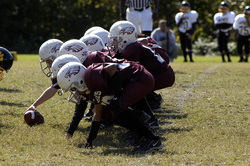
Then, one kid and I am proud to say...my kid..stepped up the week before game 3. I don't know exactly what happened except that after practice he explained it by saying, "I just got mad and needed to hit someone". And hit someone he did. There was one particular drill where he was just wiping people out, causing kids to cry he hit them so hard in practice. He came from out of nowhere that day and rose to the call. The coaches were going berserk with enthusiasm as he continued throughout that practice to raise the level of intensity for the whole team. As a Dad, I was proud. As a person, I was just absolutely inspired to see what one man...kid..could do for the entire team. I should add that he was not a big time wide receiver, nor was he the running back and not even the quarterback. He was the center. There was no glory for him just the need to take it up. He lead from behind. Our team won the next 10 games and was one game a way from returning to Disney when we lost again. Can you tell? I am still a proud father...10 years later.
Leading from behind starts with the right character, vision and selflessness to inspire; traits that servant leaders Mahatma Gandhi, Martin Luther King Jr. and Mother Teresa exemplified. These individuals all led from behind, knew there was a better way and forged the path to success through service to those they led. However, servant-leadership is effective in any field, not just social reform. Consider, for example, servant leaders in business like Herb Kelleher, Sam Walton and Max DePree.
Kelleher created and led Southwest airlines to be among the most successful companies, bucking one of the most devastating trends in its industry. Fortune Magazine even referred to Kelleher as perhaps the best CEO in America. This servant leader emphasized that people take themselves lightly, but their jobs seriously. As an example of service to those he led, Kelleher was known to spend holidays loading baggage with ground crews.
Like Kelleher, Sam Walton knew the key to success was serving the people that served the organization. Walton was famous for saying, “The folks on the front lines – the ones who actually talk to the customer – are the only ones who really know what’s going on out there. ” Walton also taught that customers were the real boss, not the stockholders.
Both Kelleher and Walton’s beliefs aligned with Max DePree, former CEO and Chairman of Herman Miller, one of America’s foremost furniture manufactures. DePree wrote “Leadership is an Art” and “Leadership Jazz”. Both books received praise from President Clinton and other famous leaders. DePree stated, “The first responsibility of a leader is to define reality. The last is to say thank you. In between, the leader is a servant. ”
Many more examples of servant leaders in business exist, like Howard Behar of Starbucks fame or Ken Melrose from the turnaround of Toro Company. There are also other companies that found success through servant leadership, companies like Medtronic, Service Master and Marriott International. Furthermore, leadership experts in academia frequently proclaim the need for servant leadership, like Jim Collins’ did in his book Good To Great.
Those who follow the path of servant leadership will have something in their favor – technology. Advances in social technologies are shifting the balance of power to the masses, thus increasing the demand for effective servant leadership and empowering those who leverage it. One recent example was the success of Barack Obama’s 2008 presidential campaign. This “community organizer” used servant leadership, empowered by effective social technologies, to help win his election. Numbers like 6.5 million online donations, 13 million email addresses, 35,000 volunteer groups, his own social networking site, 70 million online fundraisers and over 400,000 blog posts all played an undeniable factor in the election . Servant leaders today will leverage social technology tools for the success of their organizations.
When we take this opportunity to perform as servant leaders, we will ensure the future success of our organizations and our communities. How then, will leaders recognize success at leading from behind? I believe Robert K. Greenleaf the father of modern servant-leadership put it best when he said:
“The best test, and difficult to administer, is: Do those served grow as persons? Do they, while being served, become healthier, wiser, freer, more autonomous, more likely themselves to become servants? And, what is the effect on the least privileged in society? Will they benefit or at least not be further deprived?”
When answering affirmatively to these questions, the effective leader will recognize they are no longer leading from behind the curve, but ahead of it.

 RSS Feed
RSS Feed